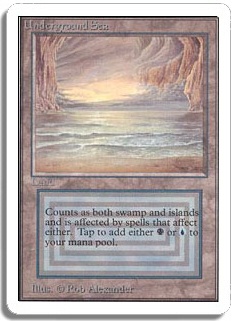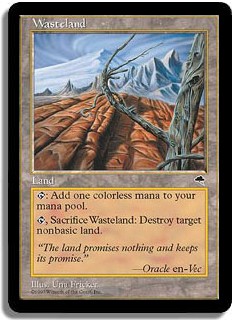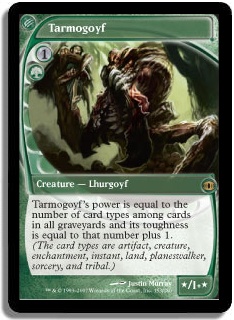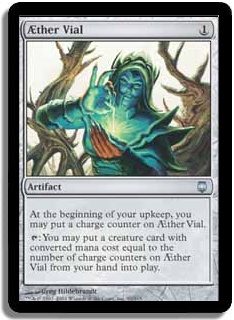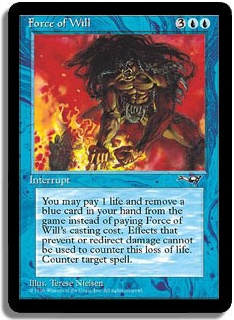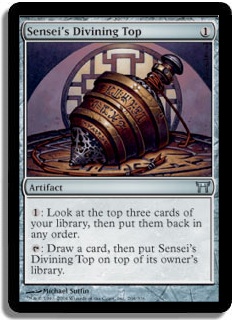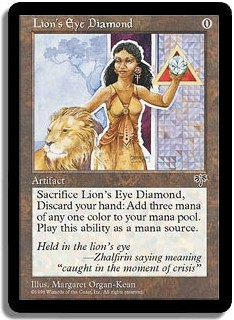I. ETERNAL, NON-ROTATING FORMATS
Formats are defined by cards, and combinations of cards, that appear with frequency over time. In some formats, for instance Block, Standard, or Extended, the legal card pool for deck construction rotates yearly; old format staples leave the format and are replaced with new meta superstars. Jace, the Mind Sculptor is a good example of this phenomenon: while currently dominant in Standard, when October rolls around and Shards block rotates out, this card’s stranglehold on the meta will be relinquished.
On the other hand, the Eternal formats, Legacy and Vintage, don’t rotate out the old sets when new ones become legal for tournament play. Unlike non-Eternal formats, in Legacy and Vintage, the dominant strategies aren’t made obsolete due to set rotation; rather, dominant or popular strategies are playable indefinitely so long as they aren’t replaced by new predatory strategies or, in the case of Survival of the Fittest, forcibly removed from the format by DCI banning.
II. THE VINTAGE POWER NINE
The fact that cards never rotate out of Eternal formats allows for powerful cards to have a long-lasting and dominant effect on the decks people play. For instance, in Vintage, because the Power 9 (Ancestral Recall, Time Walk, the Moxes, and
Timetwister
Time Vault) are so absurdly powerful in contrast to almost everything else that’s been printed since, when coupled with the fact that they never rotate, these cards, simply by virtue of existing, shape and dominate viable deck construction in the metagame.
The Power 9’s dominating influence is the function of two important factors.
They’re the best at what they do ever.
(The Power Nine are so powerful that Wizards will never print better versions; thus they’ll never be replaced by more powerful cards).
They never go away.
(Although the Power Nine are restricted in Vintage, they still dominate, and since they’ll never be banned, they’ll always reign supreme in that format).
Keeping these two qualities in mind, we can now turn the conversation to Legacy and ask the question:
“What are the Legacy equivalents to the Power Nine?”
Since Legacy, like Vintage, is the final tournament battlefield for powerful cards that have left the other formats, it makes sense that if they’re truly the best of the best and they avoid getting banned for power reasons, there must be some powerful cards that have risen like cream to the top and shape what the format looks like.
Nine is of course an arbitrary number, which I selected simply because of the allusion to the Vintage Power Nine. I could just as easily have selected eight, or twelve, etc.
III. THE LEGACY POWER NINE
Here are the nine cards that I believe most define Legacy as a format with regard to how they influence our understanding of what Legacy is and how it works. The cards aren’t in any specific order of importance, and there are even a few more cards that I felt were of, or close to the, importance of the nine I picked; however, I cut myself off at nine—and these are the nine I chose.
1. The Dual Lands:
Underground Sea, Tundra, Tropical Island, Volcanic Island, Scrubland[/author]“][author name="Scrubland"]Scrubland[/author], Taiga, Badlands, Bayou, Savannah, and Plateau
To be perfectly honest, if I had to pick the ten cards in Legacy that have a similar role to the Power Nine in Vintage, I’d pick all ten of the dual lands.
First of all, the original duals are the best mana fixers ever printed (aside from Black Lotus and Moxen, which are banned in Legacy). Dual lands are so good that if they were to be reprinted (which they never will because of the reserve list), they’d literally warp any non-Eternal format where they were legal.
For almost no drawback (yes, they count as being “nonbasic”), they provide tremendous flexibility with regard to deck construction (you can easily splash at no cost) as well as flexibility (one land, unconditionally enters the battlefield untapped, and makes two different colors).
Some people like to be clever and would tell us that the Onslaught and Zendikar fetchlands are in fact the best mana fixing lands in the game, and I’m going to give my argument for why this isn’t true. Firstly, the fetchland cycle is obviously extremely powerful, but in Legacy in particular, much of their actual usefulness derives from the fact that they have the ability to search Revised dual lands into play. Also, keep in mind that Wizards of the Coast printed fetchlands last year—and while they were very good in Standard and will continue to be good in Extended until they rotate out—they’re relatively balanced in those formats because there are no dual lands to fetch out.
Fetchlands, while very good, are timid in comparison to the duals. The fact that fetchlands are so great in Legacy is a function of contextually existing in a format where dual lands also exist, and the real reason why fetches are good is because they have the option to get dual lands. Imagine a world where fetchlands said a player could only search for a basic land—they’re substantially worse—which really demonstrates that a big part of a fetchland’s worth is being able to find a dual land.
The duals have been around forever, and people often overlook how dramatic and far-reaching their impact on Legacy is. Imagine that dual lands were never printed, and that they don’t exist. How does that change what decks are played in Legacy? I’d wager it would change Legacy in dramatic and unforeseeable ways, and the lack of the extremely effective fixing at little or no cost would cause many powerful and popular strategies to simply not exist.
At the heart of the matter here is what dual lands provide Legacy: we as players can build decks where we can basically use whatever combination of spells we choose, and because of dual lands, we can always make the mana work so that we can cast our spells.
With that being said, this article felt incomplete simply saying my Legacy Power Nine were the duals—which is why despite the fact that, combined, they count as ten cards, I only counted them as one of my choices.
Dual lands = Best mana fixing ever printed.
2. Wasteland
If the best cards in Legacy are the dual lands, it only makes sense that the best card against the duals would be among the strongest cards in the format as well.
Make no doubt about it, Wasteland is an extremely off-the-charts, overpowered Magic card. One knock that Wasteland has against it is that it’s a functionally inferior reprint of a preexisting card. It’s true that Wasteland is an inferior Strip Mine; however, hasn’t it also been said that Yawgmoth’s Bargain is an inferior Necropotence? At the end of the day, an insanely powerful card, strictly less powerful than another insanely powerful card, is still
insanely powerful.
Perhaps, Strip Mine’s overt insaneness is part of its downfall; after all, Strip Mine is banned in Legacy and restricted in Vintage—while Wasteland, its weaker counterpart, has managed to survive unhampered in both formats and has become a focal point of multiple Tier 1 strategies in both Eternal formats.
One of the reasons that Wasteland is so good is it’s perhaps the most effective card at punishing an opponent for playing with duals. As I pointed out earlier, the one drawback that a dual land actually has is that it’s nonbasic, and Wasteland, for a very low downside, provides great flexibility at attacking duals and other important nonbasic lands. It’s a land that enters the battlefield untapped and makes mana if you need it to—but, it also has the ability to trade itself for an uncounterable Stone Rain effect on nonbasics. To put the value of this effect into context, a player can trade a card and a land drop for a land-destruction effect worth roughly three mana.
The crux of many games of Legacy is based upon a player keeping a one- or two-dual-land hand and basically praying that their opponent won’t Wasteland them right out of the game. Simply playing and using Wasteland on an opponent’s first and second land drops often puts that player in such an awkward situation that it’s difficult for them to play the game.
In Legacy, there are entire strategies that revolve around using and recurring Wasteland with either Crucible of Worlds or Life from the Loam to permanently keep an opponent’s mana production suppressed. In addition to dedicated Wasteland decks, there are a whole range of different strategies ranging from very aggressive decks to control decks that take advantage of the power and flexibility of Wasteland. The fact that Wasteland has a home in aggro, control, midrange, and prison decks alike really speaks to how over-the-top the card is.
We’ve already discussed that Wasteland is an inferior reprint of Strip Mine—but to really put this comparison in context, we might examine some of the functionally inferior reprints of Wasteland that have come up in recent memory—cards such as Ghost Quarter and Tectonic Edge come to mind. Tectonic Edge is an amazing card and important in Standard right now, and it’s strictly worse than Wasteland. Unlike Wasteland, you cannot use it on an opponent who is light on land, and you have to invest one mana to use its ability! Can you even imagine what Standard would look like if Wasteland were legal?
The fact that Wasteland would likely dominate Standard and Extended makes me believe that we won’t ever see a card as good at what it does as Wasteland ever again—which means that so long as it’s legal in Legacy, it will always be a major force to be reckoned with.
Wasteland = Best mana disruption ever printed.
3. Tarmogoyf
It’s difficult to have a conversation about the best creature spell ever printed without somebody mentioning Tarmogoyf. In Legacy, a format full of free spells and cheap cantrips for value, it isn’t uncommon for this two-drop to hit play on the second turn and have between 4-6 power!
Tarmogoyf has always done well in formats where he was legal, as is evidenced by the fact that while he was in Standard, it was the most expensive card in that format. Yet, as good as Tarmogoyf was in Standard and Extended, he’s perhaps even more efficient in Legacy because of how quickly graveyards get loaded up with all sorts of different card types.
Another unfortunate side effect of Tarmogoyf is that because he’s simply a huge monster at two mana, Goyf’s presence and widespread play in Legacy really hurt the color red in the format. Before Tarmogoyf, Lightning Bolt and other one- and two-mana burn spells could be counted on to remove almost all one- and two-drop monsters in Legacy, but a two-drop fatty that’s too big to burn out, not to mention the fact that it races red, in a lot of ways makes it difficult to justify playing the color. Or, if people do play with burn spells, they’re pretty much roped into playing R/G/W, so they can splash Goyf as well as pack non-red removal for opposing Tarmogoyfs.
The flexibility that dual lands like Tropical Island afford deckbuilders makes it easy to splash Tarmogoyf, and for many blue decks, Tarmogoyf is often the only green card in the entire deck!
The biggest strength of the Goyf is quite frankly the fact that his size isn’t proportionate to his mana cost. It’s a joke that pretty much everybody already knows, but 1G is a bargain for what’s routinely a 4/5 or 5/6 body. The fact that Tarmogoyf is pretty much the best creature at being really big on the cheap and the fact that he’s a clear example of a mistakenly costed creature make it unlikely that Magic will see another monster as good anytime soon.
Tarmogoyf is also an interesting card on my Legacy Power Nine list because it’s the newest card with regard to its printing in Future Sight, a set that, though it seems relatively new, rotated out of Extended last year. So, while Tarmogoyf is an example of Wizards perhaps making a mistake with regard to fairly costing a spell, the fact that it’s been several years since a card worthy of being on this list has been printed shows how rare it may be for new cards to be printed that are of this caliber in the future.
Tarmogoyf = Most efficient creature ever printed.
4. Swords to Plowshares
Now that we know Tarmogoyf is the best value fatty in Legacy and that we can’t Bolt him, it’s only fitting that we talk about the spell that kills Tarmogoyf (and pretty much everything else) dead.
Swords to Plowshares is probably the best creature removal spell ever printed. For a white mana, a player points it at whatever critter is bugging them, and that creature is exiled. The drawback? The creature’s controller gains a few life. We all know a bargain when we see it, and Swords to Plowshares is clearly a bargain. Not only does it answer premier one-drops such as Wild Nacatl or Kird Ape for an equal mana investment, but it also blows up bigger, more expensive creatures for tempo gain!
It’s also relevant that Swords to Plowshares is the most effective way of battling Legacy’s best creature, Tarmogoyf.
Swords to Plowshares is also similar to Tarmogoyf in another regard, one that really speaks to how good both cards are at being the most efficient way to accomplish what each does; Swords and Goyf are probably the most splashed for cards in the format—meaning that people use duals and fetches for the ability to play green or white simply so they can play with one, the other, or both of these cards. Rather than find a good finisher in the colors one already intends to play or using an on-color removal spell, both of these cards are simply so amazing at what they do that the drawback of splashing is worth the gain of including them.
Also, I’d add that the fact that Swords to Plowshares exists is pretty much the only reason that control decks, such as Landstill, are even able to compete in Legacy. Slower, more controlling decks, really bank on the tempo and efficiency of Swords to Plowshares in order to survive long enough to get ahead and have their fun; the difference between a control deck winning or losing against an aggressive deck is often whether or not the control player draws one or maybe even two copies of Swords.
Swords to Plowshares = Best creature removal ever printed.
5. Aether Vial
Some might be a little bit surprised to read that Aether Vial is on my list for the Nine most format defining cards in Legacy, and truth be told, I was a little bit surprised myself. When I began making this list, there were about twenty cards that I considered to be in consideration for what I felt met the criteria of being format-defining, powerful cards—as I began to cut cards from the list and formed justifications for what actually made a card format defining, it became clear to me that Aether Vial was one of those cards.
Firstly, Aether Vial is a one-drop artifact which means that it can be played by any combination of colors that want what it brings to the table. Now let’s talk about what Aether Vial brings to the table, and why it’s so special.
First and foremost, Aether Vial is a card that makes mana, and it makes a lot of it over the course of a game when it’s properly utilized. Secondly, it gives a deck that’s playing a high concentration of creatures a lot of strategic advantages: it allows players to play creatures at instant speed on their opponent’s end step, and also it makes said instant-speed creatures uncounterable. That’s a lot of goodness.
Thus far, tribal decks have had the best success at utilizing Aether Vial, which makes perfect sense when we consider that a good tribal-themed deck is going to want to play with a lot of creatures and take advantage of the synergies between those creatures. Aether Vial allows the tribe mage to get more creatures into play quickly and also allows such a player to use their mana on their turn to do other things, such as: use abilities of lands (Wasteland, Rishadan Port, or manlands), cast counterspells, or even spin a Sensei’s Divining Top.
Goblin decks have lived and died by their Aether Vial, and there are few things less fair than a Goblin Mage who curves out using an Aether Vial with Goblin Piledriver, Goblin Matron, into Goblin Ringleader… With such a draw, the Aether Vial, over the course of five turns, ends up making its owner a remarkable nine mana—but perhaps as importantly, the Vial allows the Goblin Mage to cast his or her spells for free and thus use the mana from their lands to keep an opponent locked down under a Port or two to really keep the opponent back.
More recently, Merfolk Fish decks using Aether Vial have become one of the most successful decks in Legacy. Turn 1 Aether Vial with Daze back up is an extremely scary play from Merfolk, as is the ability of Aether Vial to threaten to drop down a Lord of Atlantis or Merrow Reejerey in the middle of combat to power up the Fish.
Make no mistake about it. Aether Vial is the single card that makes the Merfolk deck go from mediocre to excellent. Without Aether Vial, Merfolk loses its best turn 1 play and its ability to push its tempo advantage by casting free, instant-speed, uncounterable creatures. Every time I play against Merfolk in a Legacy tournament and they don’t play Vial on the first turn, I feel that my odds of winning the game improve exponentially.
Also, we should keep in mind that Aether Vial was banned in Mirrodin Block Constructed, as well as Extended. Cards that were too powerful for the DCI to wait until they rotated are usually cards that are tremendously powerful, and Vial is no exception. In fact, my personal opinion is that Aether Vial is probably one of the most overpowered and borderline degenerate cards in Legacy. It wouldn’t surprise me in the slightest if someday Aether Vial ended up banned in Legacy, especially if Wizards continues the trend of printing really powerful and efficient creatures in the future—however, for the time being, I think it’s fine and shouldn’t be banned.
My point is that Aether Vial is one of those cards that what it
does
is always teetering on the edge of being either really, really good or obnoxiously broken. Legacy is a diverse enough format that decks have always been able to defend themselves against creature decks—yet, as long as Aether Vial exists, it will be without a doubt the best creature deck enabler in the format.
Aether Vial = Best creature enabler
6. Force of Will
I can’t imagine that anybody will be particularly surprised that Force of Will makes my list of the nine most format defining cards in Legacy. In a format where it’s possible and common to face off against extremely fast combo decks, a counterspell that can be played without paying mana is going to be at a premium.
Force of Will is a card that I’ve heard described as “The Glue,” of Eternal formats as it’s truly the one card that always helps to keep degenerate combo decks with the ability to win on turn 1 or 2 from dominating formats full of powerful cards. A free counterspell creates an interesting situation—on the one hand, it’s an absurdly good card. A hard counter that doesn’t require mana to play is obviously going to be borderline insane, especially when we consider that counterspell decks can tap out on their turn and still counter an opponent’s play. Yet, the fact that Force of Will exists, despite being perhaps overpowered, is still a good thing because it keeps fast combo decks from being able to run the table.
The existence of a free counterspell is one of the defining characteristics of Eternal formats, and because the card sees so much play, the decks that don’t play it have adapted to be able to beat it. Cards like Aether Vial, for instance, are one way that creature decks can get their critters in play through strong permission spells like Force. Decks like Zoo play a lot of extremely efficient cheap drops that have a high power curve and by doing so make the disadvantage of pitching another blue card and paying a life relevant because the aggro deck can present lots of threats quickly, and thus the tempo gained by Force of Will isn’t crippling.
In Legacy, it’s telling that most of the decks that play enough blue cards to support Force of Will’s alternate casting cost also play with Force of Will; it’s one of those cards that really transcend archetypes: blue tempo decks, aggro decks, control decks, and even combo decks all make use of Force of Will.
Force of Will = Best permission spell ever printed
7. Sensei’s Divining Top
Like Aether Vial, Sensei’s Divining Top is a one-drop artifact that fits into many different top-tier Legacy decks. Most notably, Top is one half of the powerful Counterbalance/Top combo that can outright lock an unfortunate opponent right out of the game.
Sensei’s Divining Top is one of those cards that’s simply pure value all the time, and the subtle advantages it provides with regard to card selection really adds up to a large advantage over the course of the game. Decks that utilize Sensei’s Divining Top make use of lots of shuffle effects thanks to their fetchlands and are constantly looking at a lot of fresh cards—which gives that deck’s pilot perhaps double or triple the amount of lines of play that an opponent without Top might have.
Perhaps the thing that makes Sensei’s Divining Top such a force in Legacy is that it requires a very low cost to play, one colorless mana, and it gives a player something relevant to do whenever they have extra mana available. In addition to being a very solid card in its own right, when paired up with Counterbalance, the combination of the two cards can outright take an opponent completely out of the game.
Over the years, I’ve seen Sensei’s Divining Top in pretty much every single type of deck that I can possibly think of. I’ve seen people play with Top in everything from mono-red burn decks, to Tendrils of Agony decks, to Control decks, and to everything in between.
Whether people are pairing it up with Counterbalance to lock an opponent out of a game or simply using it to smooth out draws in a junk deck, it’s undeniable that Sensei’s Divining Top is widely played and an extremely powerful card in the Legacy toolbox. The ability to use Sensei’s Divining Top over and over again to generate lots of small advantages with card selection is invaluable, as is the fact that because you can tap it to draw a card and put it on top of your library makes it almost indestructible in most situations—so not only is it really, really good, but also it’s really, really hard to kill. At the low, low cost of one colorless mana, Sensei’s Divining Top is quite a bargain and one of the cornerstone cards of Legacy.
Sensei’s Divining Top = Best library manipulation in Legacy.
8. Brainstorm
If Sensei’s Divining Top is the best card at milking small, calculated advantages slowly over the course of many turns, Brainstorm is easily the best library manipulation spell that gives a player a huge advantage in card selection immediately.
Once again, Brainstorm is a card that hails from the olden days of card design where people were unsure how good certain mechanics, especially library manipulation, actually was in the scheme of Magic-related mechanics. Let’s just say that for a single blue mana, getting to draw three cards and put two cards from your hand on top of your library in any order is an extremely powerful effect.
This is basic card selection theory, but if you have two blanks in your hand and cast Brainstorm and then shuffle the two blanks away, it’s very similar to virtually drawing three cards. Not to mention Brainstorm also affords players a way to put cards from their hands back into their deck; no small advantage when one considers that having Natural Order and Progenitus in one’s hand at the same time is mighty awkward.
Also, Brainstorm gives a player a way to respond to an opposing player’s Duress or Thoughtseize and put a useful card on top of one’s library so as not to be taken by the hand disruption spell.
Almost every competitive deck that can produce blue mana (aside from some Merfolk decks (which need to have lots of fishy creatures) plays with Brainstorm. Brainstorm’s greatest strength is that it really smooths out draws, especially if a player has drawn cards that are virtually useless in a certain matchup. For instance, against a combo opponent, a player draws two copies of Swords to Plowshares—but, fortunately he or she also has Brainstorm, casts it, draws three new cards, puts the two Swords to Plowshares on top, cracks a fetchland, and problem solved.
Brainstorm is also interesting because it’s the first card on my list so far that’s actually restricted in Vintage. A card has to be pretty strong in order to deserve a spot alongside Ancestral Recall or Time Walk on that list. Also, Brainstorm is the only card on my list whose rarity is common.
Brainstorm = Best card draw legal in Legacy.
9. Lion’s Eye Diamond
Choosing the last card on the list was actually a little bit difficult, as there are a lot of really powerful cards in Legacy and obviously only nine slots on my list. I selected Lion’s Eye Diamond because I felt that it is, at the end of the day, the most degenerate card that tends to show up in most of the degenerate combo decks. Honestly, it was close, and my other choice was Dark Ritual—but I went with LED, and here’s why.
Pretty much all of the Tendrils of Agony combo decks in Legacy play Dark Ritual and Lion’s Eye Diamond, but there are actually some other combo decks that play with Lion’s Eye Diamond that don’t also include Dark Ritual. For example, Belcher decks are wildly fast R/G decks that essentially try to either produce and activate a lethal Goblin Charbelcher activation on the first turn or cast a large Empty the Warrens on the first turn. Lion’s Eye Diamond is really, really good in such a deck—especially in combination with Burning Wish—since one can cast Burning Wish and in response sacrifice Lion’s Eye Diamond and then cast what the Burning Wish finds with the LED mana.
I’ve also seen Lion’s Eye Diamond be very successful in Dredge decks, for instance the Dredge opponent who killed me on the first turn at GP Chicago…
In the same way that Wasteland is a
bad
Strip Mine; Lion’s Eye Diamond is a
bad
Black Lotus—and as far as I’m concerned a bad Black Lotus is usually better than most other Magic cards. Lion’s Eye Diamond is the card that always seems to show up in decks that are trying to do extremely unfair things very quickly—whether it’s Tendrils of Agony, Goblin Charbelcher, or Dread Return, if there are unfair shenanigans to be had on the first turn, then chances are Lion’s Eye Diamond is probably involved.
Lion’s Eye Diamond = Best broken mana accelerator in Legacy.
IV. SIGNIFICANCE
Now that we have a rough idea about what the nine most format defining cards in Legacy are, let’s talk about why knowing is important. Firstly, most of the best decks in Legacy play with at least one card from this list—and most of the strong decks in Legacy overlap and play with multiple cards from this list.
Let’s take a look at the major players in Legacy and see how they utilize the cards from my Legacy Power Nine list:
Merfolk:
Force of Will, Wasteland, Aether Vial, and sometimes dual lands.
Landstill:
Force of Will, Brainstorm, Wasteland, dual lands, Swords to Plowshares, and sometimes Sensei’s Divining Top.
Goblins:
Aether Vial, Wasteland, and dual lands
Ad Nauseam:
Brainstorm, Lion’s Eye Diamond, and dual lands
Counter/Top:
Force of Will, Brainstorm, Swords to Plowshares, Tarmogoyf, dual lands, and Sensei’s Divining Top.
B/U/G Tempo:
Force of Will, Brainstorm, Tarmogoyf, Wasteland, and duals.
Most of the top-tier decks in Legacy play with between three and six of the nine cards on my list in their main deck; as they rightly should if these nine are in fact the outright format defining cards in Legacy.
The purpose of pointing out that the best decks play with some combination of these “best” nine cards is that viable Legacy decks are those that can best take advantage of using these cards. From a deckbuilder’s perspective, it may be useful to start thinking about decks in terms of how they’re able to either use, or answer, strategies directly relating to these nine cards.
While it’s possible to play decks that don’t play with any of these cards, it’s my belief that one must have a really good reason for not including as many as possible. Enchantress is a really good example of a deck that doesn’t play with very many cards from this list—just dual lands. However, Enchantress is able to remain viable because it takes advantage of powerful synergies between cards that are individually less stunning, but together do great things. Enchantress also takes advantage of cards like Argothian Enchantress and Serra’s Sanctum that are difficult to use in non-Enchantress strategies—but that are individually extremely powerful, linear cards.
For the past few weeks, I’ve been focusing pretty heavily on Legacy, and the deeper I dig into the format, the more interesting and complex it seems to become. With Survival of the Fittest banned, I think that a lot of new and exciting things are on the horizon in the metagame—understanding the fundamentals, such as the cards that define the format and why, gives savvy deck designers a big advantage in building better decks moving forward.
Hope you enjoyed the article.
Cheers,
Brian DeMars

